Estimating Age of Death from Subadult Remains, Part 1
The long-standing problem of estimating the age and sex of subadult skeletal remains has been significantly "solved" with the advances in understanding the growth and development patterns in the skeletons of young people. Kyra Stull, an anthropologist and forensic researcher at University of Nevada, Reno, and Danielle McLeod-Henning, a physical scientist at NIJ, share more about this research with NIJ writer and host Jim Dawson.





